Cooking With The Most Expensive Spice In The World - Saffron!

The most precious and most expensive spice in the world: Saffron.
The Saffron filaments, or threads, are actually the dried stigmas of the saffron flower, "Crocus Sativus Linneaus". Each flower contains only three stigmas. These threads must be picked from each flower by hand, and more than 75,000 of these flowers are needed to produce just one pound of Saffron filaments, making it the world?s most precious spice.
But, because of saffron's strong coloring power and intense flavor, it can be used sparingly. Saffron is used both for its bright orange-yellow color and for its strong, intense flavor and aroma.
Crocus Sativus Linneaus contains crocin, the source of its strong coloring property, bitter-crocin, which offers the distinctive aroma and taste and essential oils which are responsible for its therapeutic properties.
Saffron is available both in filaments and powder, though the long, deep red filaments are usually preferable to the powder as the latter can be easily adulterated.
Today, the greatest saffron producing countries are Greece, Spain, Turkey, Iran, India, and Morocco.
The largest saffron importers are Germany, Italy, U.S.A., Switzerland, U.K., and France.
Okay... now...after you read that information about Saffron, you can appreciate it more on why Saffron is so expensive. I bought Saffron from my grocery store, it comes in a bottle and inside the bottle there is an paper envelop containing 1 tsp of saffron threads for the price of CAN $ 13.

Another great place to buy it is from Ebay. I bought my vanilla beans also from Ebay, direct from Tahiti. A lot cheaper than if you buy from your grocery.
Here is the background story on why I want to try cooking with saffron. Here at my home, FoodTV Network is always on my TV as long as Richard is still at work and Kai Kai is at his school. I think in the past 2 years or so I notice that I mention about a Spanish dish called Paella more and more and to cook Paella, you need saffron because saffron is what makes this dish special. The color and the flavour of saffron.
Since saffron is so expensive, I thought I want to eat Paella at a restaurant first so I know approximately what Paella should taste like. I did this couple months ago actually and I think I like Paella even though I still couldn't taste what so special about saffron except it makes the rice looks yellow but that easily can be duplicate by using turmeric. In fact, some recipe calls for turmeric as a replacement of saffron. True, the color is the same, but they said the flavour is different. Because of that I want to use saffron so I can get the whole thing right first.
To make sure that I get it right. I insist on buying everything fresh. I went shopping early in the morning so I can get the live shrimps, live clams, live mussels and the white wine.

Paella
From America's Test Kitchen
This recipe is for making paella in a Dutch oven (the Dutch oven should be 11 to 12 inches in diameter with at least a 6-quart capacity). With minor modifications, it can also be made in a paella pan (see instructions below). Dry-cured Spanish chorizo is the sausage of choice for paella, but fresh chorizo or linguiça is an acceptable substitute. Soccarat, a layer of crusty browned rice that forms on the bottom of the pan, is a traditional part of paella. In our version, soccarat does not develop because most of the cooking is done in the oven. We have provided instructions to develop soccarat in step 5; if you prefer, skip this step and go directly from step 4 to 6.
Serves 6
1 pound extra-large shrimp (21/25), peeled and deveined
Table salt and ground black pepper
olive oil
8-9 medium cloves garlic , minced or pressed through garlic press (about 2 tablespoons)
1 pound boneless, skinless chicken thighs , each thigh trimmed of excess fat and halved crosswise
1 red bell pepper , seeded and cut pole to pole into 1/2-inch-wide strips
8 ounces Spanish chorizo , sliced 1/2 inch thick on the bias (see note)
1 medium onion , chopped fine (about 1 cup)
1 can (14 1/2 ounces) diced tomatoes , drained, minced, and drained again
2 cups Valencia rice or Arborio ( I also read somewhere that you can substitute it with Japanese sushi rice )
3 cups low-sodium chicken broth
1/3 cup dry white wine
1/2 teaspoon saffron threads , crumbled
1 bay leaf
1 dozen mussels , scrubbed and debearded
1/2 cup frozen green peas , thawed
2 teaspoons chopped fresh parsley leaves
1 lemon , cut into wedges, for serving
1. Adjust oven rack to lower-middle position; heat oven to 350 degrees. Toss shrimp, 1/4 teaspoon salt, 1/4 teaspoon black pepper, 1 tablespoon oil, and 1 teaspoon garlic in medium bowl; cover with plastic wrap and refrigerate until needed. Season chicken thighs with salt and pepper; set aside.
2. Heat 2 teaspoons oil in large Dutch oven over medium-high heat until shimmering but not smoking. Add peppers and cook, stirring occasionally, until skin begins to blister and turn spotty black, 3 to 4 minutes. Transfer peppers to small plate and set aside.
3. Add 1 teaspoon oil to now-empty Dutch oven; heat oil until shimmering but not smoking. Add chicken pieces in single layer; cook, without moving pieces, until browned, about 3 minutes. Turn pieces and brown on second side, about 3 minutes longer; transfer chicken to medium bowl. Reduce heat to medium and add chorizo to pot; cook, stirring frequently, until deeply browned and fat begins to render, 4 to 5 minutes. Transfer chorizo to bowl with chicken and set aside.
4. Add enough oil to fat in Dutch oven to equal 2 tablespoons; heat over medium heat until shimmering but not smoking. Add onion and cook, stirring frequently, until softened, about 3 minutes; stir in remaining garlic and cook until fragrant, about 1 minute. Stir in tomatoes; cook until mixture begins to darken and thicken slightly, about 3 minutes. Stir in rice and cook until grains are well coated with tomato mixture, 1 to 2 minutes. Stir in chicken broth, wine, saffron, bay, and 1/2 teaspoon salt. Return chicken and chorizo to pot, increase heat to medium-high and bring to boil, uncovered, stirring occasionally. Cover pot and transfer to oven; cook until rice absorbs almost all liquid, about 15 minutes. Remove pot from oven (close oven door to retain heat). Uncover pot; scatter shrimp over rice, insert mussels hinged side down into rice (so they stand upright), arrange bell pepper strips in pinwheel pattern, and scatter peas over top. Cover and return to oven; cook until shrimp are opaque and mussels have opened, 10 to 12 minutes.
5. Optional: If soccarat (see note) is desired, set Dutch oven, uncovered, over medium-high heat about 5 minutes, rotating pot 180 degrees after about 2 minutes for even browning.
6. Let paella stand, covered, about 5 minutes. Discard any mussels that have not opened and bay leaf, if it can be easily removed. Sprinkle with parsley and serve, passing lemon wedges separately.
7. If You're Using a Paella Pan
A paella pan makes for an attractive and impressive presentation. Use one that is 14 to 15 inches in diameter. A 14-inch ovensafe skillet will work as well, but do not attempt to use anything smaller because the contents will simply not fit. Follow the recipe for Paella, increasing the chicken broth to 3 1/4 cups and the wine to 1/2 cup. Before placing the pan in the oven, cover it tightly with foil. For soccarat, cook the paella, uncovered, over medium-high heat for about 3 minutes, rotating the pan 180 degrees after about 1 1/2 minutes for even browning.
STEP BY STEP: Deveining Shrimp
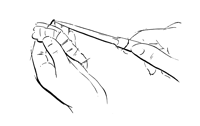
1. Hold the shelled shrimp between thumb and forefinger and cut down the length of its back, about 1/8 to 1/4 inch deep, with a sharp paring knife.
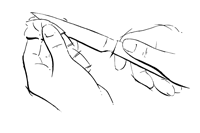
2. If the shrimp has a vein, it will be exposed and can be pulled out easily.
STEP BY STEP: Searching for Soccaret
Soccarat is the toasty, browned portion of rice that forms along the bottom of the pan. It is the hallmark of authentic paella. To create this crusty bottom layer of rice, return the Dutch oven to the stovetop for five minutes once the paella has finished baking.
STEP BY STEP: How Much Time is Enough for Good Paella?
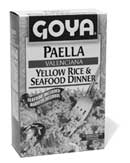
30 MINUTES: This boxed paella, with its own can of seafood, isn't worth the minimal bother.
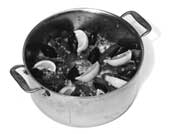
TWO HOURS: Our recipe works in a pan you already own and relies on a reasonable shopping list.
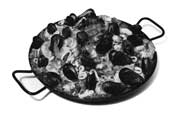
FOUR HOURS: This ultimate recipe requires a paella pan and includes nine kinds of meat and seafood.

Above: Different sizes of Paella pans.
NOTE:

It's a good idea to get all the ingredients ready before you start cooking because between cooking one ingredient to another, it only takes few minutes so you don't have much time to do anything else beside cooking one ingredient after another.
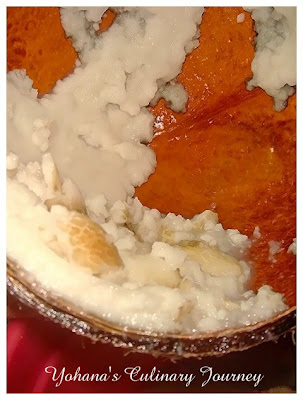
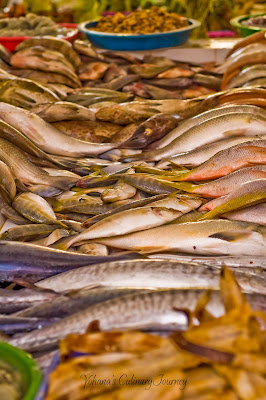
Comments